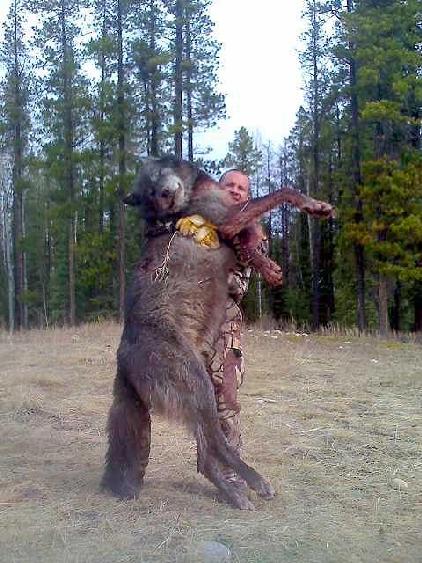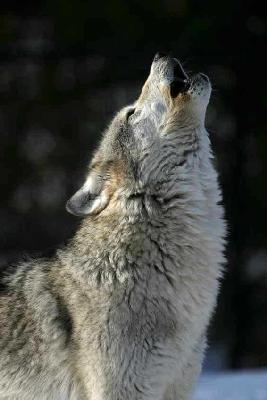

From the June 2009 Idaho Observer:
Idaho home to some 4,000 of the biggest, baddest wolves in the world From 35 transplanted specimens as of 1996, the federally "reintroduced"
Canadian gray wolves have multiplied and spread throughout the northern two-thirds
of Idaho and are decimating wild game herds. This "nonessential" program
is a complete failure according to some but a masterstroke in diabolical federal
occupational planning.
|
|
|
By Don Harkins
STANLEY—The Idaho Department of Fish & Game (IFG) map and the photo in this article show that the wilds of Idaho are being "patrolled" by one of the largest and meanest wolf sub species in the world. Additional photos and live video support claims that these huge predators are not food chain balancers as some contend but vicious, pathological killers. "If the devil had an animal, it would be the Canadian Gray Wolf," said Ron Gillett of the Idaho Anti-Wolf Coalition.
Wolves were listed as "endangered" in 1974 per the Endangered Species Act. The U.S. Fish and Wildlife Service 1987 Wolf Recovery Plan culminated in the placement of a total 35 "certified" rabies-free wolves from Alberta and British Columbia, Canada, in central Idaho in 1995 and 1996. In 2002, the Idaho legislature adopted the Idaho Wolf Conservation and Management plan turning the responsibility of wolf management in the state over to IFG. Since an agreement between Idaho and the U.S. Department of the Interior was struck in Jan., 2006, the state has served as an agent for the U.S. Fish and Wildlife service in the day-to-day management of wolves in Idaho.
According to IFG, Idaho currently has 846 wolves in 88 packs of which 39 are considered "breeding packs." Gillett believes the IFG estimate is based upon incorrect data and that field experience shows the number is closer to 4,000. "You cannot manage these animals in any number," Gillett explained, citing the rugged nature of the terrain and the wolves’ range and mobility as well as their reproduction capacity. IFG claims that Canadian gray wolves maintain strict breeding habits and constantly refer to "mating pairs" that produce one litter of three to six pups each year. But Gillett and others claim that female wolves are having up to two litters of six to 12 pups each year and that the "mating pairs" term is used to curry public support for a program that has gone out of control by romanticizing wolves.
Another myth is that wolves help to maintain balance in nature. This and many other myths are being challenged by the Save Our Elk Coalition at www.saveelk.com. The group claims that mountain ungulate (hooved animal) populations are rapidly decreasing in regions of Idaho, Montana and Wyoming where wolves are thriving. It is generally understood that each adult wolf consumes 16-24 hooved animals (primarily deer, elk and moose) per year. But the number must be doubled to factor in the number of ungulates these wolves are killing for "sport." The forests are being littered with carcasses of animals attacked by wolves and left to die or rot. According to Gillett, who states that he has photo and video evidence to back every claim he makes, wolves will wait until a deer, elk or moose cow is giving birth and then attack and kill both cow and newborn calf and either eat them or just leave and go onto the next kill. Canadian gray wolves also dig up hibernating black and grizzly bears and kill them for both food and sport. "When these wolves are hunting in a pack, they aren’t afraid of anything and will attack healthy and mature grizzly bears and adult male moose," Gillett said.
Gillett explained that the news media popularly identifies Osama bin Laden as a political terrorist and persistent corporate polluters as environmental terrorists. "The wildlife terrorist is the Canadian gray wolf," Gillett said.
These wolves evolved to their tremendous size, strength and ferocity in the far north where widely ranging moose and caribou, which are much more difficult to catch and kill, were their main food source. The harsh climates and limited food supply has traditionally balanced moose, caribou and Canadian gray wolf populations in northern Canada and Alaska. But in Idaho, for instance, with its milder climates and more plentiful/easier to catch food supply—which is increasingly inclusive of livestock and domestic dogs—these predators are quickly unbalancing nature. The Save Our Elk Coalition notes that, once the displaced predators outstrip their food supply, "...they will turn on each other in a war of survival. They didn’t ask for this fate. We brought it on them by bringing them down here where they clearly do not belong."
As of May 4, 2009, wolves are no longer listed as endangered per the Endangered
Species Act and are now managed under the Idaho Wolf Population Management Plan
and Idaho State Code 36-1107. Governor Butch Otter, who once claimed that he
would take out the first license to hunt wolves, has tacitly recanted after
being severely criticized for his comments. Rex Rammell, who is running for
governor, has vowed to repeal the statutes authorizing the state’s wolf management
plan if elected. "As governor, I will use every legal means to remove the
wolves. It is not in the best interest of our native wildlife, the true gems
of Idaho, to maintain any number of the most effective killing machines God
ever created," Rammell states on his website at www.voterammell.com.

Gillett has noticed an increase in the numbers of people interested in Idaho’s wolf population. "After founding the Idaho Anti-Wolf Coalition a few years back, we were lucky if 10 people showed up at one of our presentations. Today, wherever I go, particularly in central Idaho, the epicenter of Idaho wolf ‘reintroduction,’ it’s standing room only in rooms filled with people who want the wolves out of our state," he said.
In fall, 2009, Gillett and a few of his associates are planning a statewide speaking tour to increase public awareness about the growing wolf problem. The IO plans to help promote events in Bonners Ferry, Sandpoint and Coeur d’Alene.
Gillett understands that this is a highly controversial and emotional issue. But, he has seen how "wolf lovers," after being exposed to the true science and politics behind the planting of non-native Canadian gray wolves in Idaho and shown live images of the damage these displaced predators are causing, their opinions of the subject change. For those whose minds cannot be changed, Gillett is willing to defend his anti-wolf position by publicly debating anyone willing to take the pro-wolf position. "The experiment is over and it failed," Gillett said.
For those with access to the Internet, go to www.saveelk.com for a full understanding of the anti-wolf position (be advised that some of the photos and video footage is extremely graphic). From there it is easy to find information from the pro-wolf perspective.